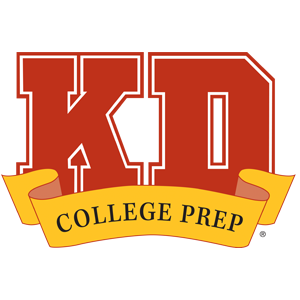As I coach students for the college admissions exams, they will often ask how to improve reading comprehension performance on the SAT®, PSAT, and ACT® tests.
These questions come as no surprise. The “Reading” section is one of the more daunting segments of the test for many students. These sections contain passages that consist of about 500-750 words, and they tend to slow students down and stress them out.
If you struggle with this aspect of the test, you are not alone! For nearly 30 years, KD College Prep has helped students master these sections of the tests so that they can earn the score needed to attend their dream colleges. Here are our top 13 ways to boost your reading score on the SAT, PSAT, and ACT tests.
1. Improve your timing
While preparing, timing yourself can be helpful. You want to build up your reading speed, and this will take lots of practice if you are naturally a slow reader. The key is to read in a targeted way that helps you find the correct answers quickly.
If you’re a deep reader, you may struggle to manage time efficiently on college admission exams. Deep readers tend to read much more slowly than those who typically “skim” through the text.
While taking in all the details can be helpful, you don’t want to spend so much time reading a passage that you don’t have time to answer all the questions.
On an SAT test, students have 13 minutes to read a single passage and answer 10-11 questions about that passage. Each passage consists of about 500-750 words. Students have to do this five times in a row since there are five passages to cover in this 65 minute section.
On the PSAT test, students have 12 minutes to read a single passage and answer 9-10 corresponding questions. The PSAT reading section will be very similar to the one on the SAT test in terms of format with slightly shorter passages and fewer questions.
On an ACT test, students have a whirlwind of just under nine minutes per 10 questions attached to a passage. They have to complete questions for four passages in 35 minutes.
2. Find a balance when reading
While it is important to be efficient, skimming the content too quickly can hurt your chances of finding the correct answer. You don’t want to have to waste precious time by going back through a passage to pick up on what you missed during the first read-through.
It will take practice, but you need to find the balance between skimming and deep reading. I often tell my students to “glean quickly.” The key here is that sometimes you will need to focus on the details, and other times you’ll need to understand the main idea. Read too fast, and you might miss out on both.
3. Read college-level texts
The answer to this may seem obvious, but the best way to read better is to read more and to read widely in college-level genres. Not only are the questions on the reading section specifically designed to trick students, but passages may be taken from many different time periods and cover a variety of genres at a college reading level.
Keep in mind that while you are prepping for these exams, the big picture is that you are preparing for college classes. Whether or not you choose to major in literature, philosophy, history, or political science, familiarity with important works in the humanities will help you understand the complexities of human societies and give you a well-rounded perspective in STEM fields.
Additionally, many high level college courses are interdisciplinary or have heavy reading loads on their syllabi—think along the lines of 50-70 pages per night—so getting used to gleaning important information quickly is a good strategy for college course loads.
History
For example, a very common genre of passage chosen for the SAT reading section is original American documents from the late 1700s. These documents are usually about the founding of the United States and arguments surrounding the development or ratification of the Constitution. These are documents that exist in the real world and have historical contexts attached to them.
While you won’t be required to know the history to answer questions on the test, familiarizing yourself with these types of arguments and the high-level, legal vocabulary used in them will give you an edge on these passages.
Make the most of the times in school when you are assigned reading in original documents and seek out some of these famous documents (e.g., The Federalist Papers) on your own to get ahead of your peers.
Literature
Similarly, a frequently chosen genre on the exams is prose fiction or literature. On a literature passage, you’ll need to identify characters and characteristics of those characters to answer questions.
You’ll also need to follow dialogue at times. My advice is to choose a popular classic like Little Women or Pride and Prejudice and challenge yourself to read and understand these pieces. Even if you simply watch the movie adaptations of these famous works of literature, you might have a better grasp on the social contexts and dialogue styles covered in these older stories.
Science
Another common genre you’ll encounter on the tests is science. In fact, on the ACT test there is an entire section dedicated to reading and answering questions related to science passages.
Keep in mind that the ACT science section is not a test of your content knowledge. While having a strong scientific foundation may certainly give you more confidence for this section of the test, you do not have to rely solely upon prior scientific knowledge.
Instead, the ACT science section draws heavily on your reading comprehension, data analysis, and critical thinking skills. What’s more, all of the information you need to answer the questions is somewhere on the page; you just have to be able to find it quickly.
On the SAT test, science passages appear in both the reading and writing sections. There is a wide range of scientific topics that may be covered, some that you may be familiar with from high school science and some that you may not be.
While the ACT science section counts for a full quarter of your ACT score, your performance on the science passages on the SAT will be integrated into your reading and writing scores.
While you won’t have to memorize complex scientific formulas for these sections, it will help to have an understanding of the scientific method and the fundamentals of experiment design. It’s important to pay attention during your science courses in high school, as the content you read in these classes could help you become more familiar with science problems on admissions tests.
At KD College Prep, we offer bonus lessons for the ACT science section to help students build understanding of these types of questions.
4. Practice advanced vocabulary
One common way that students prepare for the reading sections on their own is to create flashcards using definitions of commonly tested vocabulary words. Our opinion of this strategy: it is not enough.
An improved reading score will take more than just flipping through a deck of flash cards. Back in the day, the verbal section of the SAT test used to put a heavy emphasis on simply understanding word definitions, but this is no longer the case.
You’ll need to be able to recognize small distinctions between words and how to use context clues to choose the correct synonyms for them. These types of questions can be complex, and you’ll find it more challenging to study for them on your own.
Our experienced curriculum writers have designed a self-paced vocabulary workbook for our students that goes beyond the flash cards. In these units, you’ll find exercises that offer tricky answer choices to build stronger understanding of how to assess word tone and context.
The Vocabulary Workbook is included as extra practice in our test prep programs, and students are provided with teacher explanations for each vocabulary unit.
5. Stay engaged when reading a passage
The passages found in your test booklet are educational, and sometimes you’ll come across a subject that you find uninteresting. After all, the test was written to assess your level of knowledge rather than entertain you.
Believe it or not, your mindset does have an impact on your performance. If you get bored and lose interest while reading, you probably won’t retain any of it. You’ll have to trick your mind into wanting to read the passage. To push yourself in the right direction, try to think about the positives instead of getting frustrated or wishing you were spending your Saturday elsewhere.
Before walking into the test, remember how hard you’ve worked to get here or give yourself an internal pep talk. If you start the test with a positive mindset and remind yourself why you’re there, it will help motivate you to stay focused on the test as a whole, especially when reading a passage.
6. Take notes as you read!
One way to stay engaged while reading is to underline or circle the most important points or take notes while reading through the passage.
Remember, you want to use your time as efficiently as possible! Note-taking becomes helpful when you have to go back and look through the passage to find the correct answer.
7. Start with the questions
While the test is structured to have the reading passage come first, that doesn’t mean you have to start with the reading. Sometimes it’s helpful to read through the questions in advance so that you know what to look for when reading the passage.
Knowing the questions ahead of time makes it easier to take the right notes and can help you move through this section more quickly.
8. Don’t fall for traps
As we already mentioned, the questions on the SAT, PSAT, and ACT tests are carefully written to mislead you. Be conscious of this when reading through each question.
If you familiarize yourself with test material beforehand, you’ll be able to identify these cleverly worded questions. Remember, every right answer adds to your score, so always try to minimize your mistakes whenever possible.
9. Attend test prep classes
Through our instructor-led test prep programs at KD College Prep, we teach logical, effective strategies to help students efficiently analyze and answer questions on these exams. In our verbal lessons, we teach 50 strategies that students can then apply to the test. These strategies show students how to improve reading speed, annotate helpful details, and eliminate weak answer choices.
While there are recurring patterns and question types that students can master with our prep courses, it can take time for a student to grow his or her own proficiency in these areas. This is one of the reasons we recommend starting test prep in 9th or 10th grade (as 11th grade is the big testing year for most students).
Through our Complete™ Program, we work with each individual student on his or her testing timeline to build students’ confidence and control over their test performance.
10. Focus on your weaknesses
If you’re reading this article and have already taken the test for the first time, then this part is for you. After taking the initial test, you should have received a score report that includes an analysis of the questions you missed.
On the SAT score report, you can find this under the “Subscores” section. For example, reading questions are categorized as Command of Evidence, Words in Context, Expression of Ideas, and Standard English Conventions.
On the PSAT score report, there will be a breakdown of your answers by each section and question. You’ll need to log into the PSAT website to access your subscores.
On the ACT score report, you’ll be able to see the section scores under “Detailed Superscore Results.” From there, you can see which questions you missed under the following categories: Key Ideas & Details, Craft & Structure, Integration of Knowledge & Ideas, and Understanding Complex Texts.
By breaking down your score report, you’ll be able to identify the areas where you need to improve the most. Don’t waste your time studying aspects of the test in which you already scored far above average. Focus on the sections where your score was the lowest.
When registering for a test on select dates, you also have the option to request the answers from the test (although it does cost extra). It never hurts to be able to see exactly which question you missed so that you can avoid these mistakes on future test dates.
Our test prep courses at KD College Prep go over all types of questions on the SAT, PSAT, and ACT tests. If there is a specific question type that you struggle with, we also offer one-on-one tutoring sessions in which an instructor can help you improve in that specific area.
11. Take practice tests
Taking practice tests is one of the most effective ways to prepare for college admissions tests. Why not try to get a feel for the test ahead of time so that you know exactly what to expect on test day?
Students should start taking practice tests as early as 9th grade to give themselves plenty of time to master each type of question found on the tests. We recommend that students take full-length practice tests instead of testing for just one section at a time.
Taking a test is like running a marathon. The first attempt will be a challenge, but over time you’ll build up mental endurance. In other words, it will become easier the more you practice taking tests in their entirety.
KD College Prep offers practice tests in PSAT, SAT, and ACT formats. These allow students to practice in a timed, proctored environment.
12. Give yourself time to prepare
A lot of students don’t like to hear this, but there is no “quick fix” that will instantly boost your test score. These tests are complex, and while there are a variety of strategies you can put into place to improve your overall performance, it will take time to learn how to effectively improve your score.
If you take anything away from this article, let it be this: do not stay up late and “cram” the night before a test. Cramming will just make you more tired and add to your anxiety on test day. For the best results, make sure to plan ahead.
13. Ask for Help
Some students are able to prepare sufficiently for these tests on their own, but many students benefit from having support and guidance throughout the testing process.
If you struggle with reaching your target test score, it may be time to pass the baton to our team of test prep experts. Through a variety of flexible test prep programs, we’ll help you create a flexible prep schedule that works best with your busy routine.
Through our Complete™ Program, we also offer ongoing college planning and guidance seminars to help families stay on track throughout the entire college admissions process.
We’ve been helping students through this process for decades, so let us be a resource for you! To learn more about our test prep or college counseling programs, contact us to schedule your free consultation.































